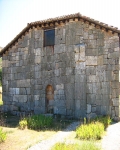Santa Maria de Lara
Archaeology »
Archaeological Monuments » Santa Maria de Lara
Santa Maria de Lara - Spain
Santa Maria de Lara is located in Quintanilla de las Vinas.
Santa Maria de Lara monument was established on 711AD.
Primary threats to Santa Maria de Lara :
The church of Santa Maria de Lara, also known as the Ermita (hermitage) de Santa Maria, is one of the last surviving Visigoth churches on the Iberian Peninsula.
Historical facts of Santa Maria de Lara :
- Santa Maria de Lara is a historical site located in the region of Burgos, in northern Spain. This ancient complex holds significant importance as one of the most remarkable examples of Visigothic architecture and is an essential part of Spain's cultural heritage. The site comprises a church and a necropolis, revealing fascinating insights into the religious and burial practices of the early medieval period.
- The Church of Santa Maria de Lara, also known as the Hermitage of Santa Maria de Lara, stands as an exceptional representation of pre-Romanesque architecture. It dates back to the 7th century, making it one of the oldest Christian buildings in the Iberian Peninsula. The church's construction showcases the amalgamation of Visigothic, Mozarabic, and Romanesque influences, making it a unique architectural treasure.
- The church's design is relatively simple yet elegant. It consists of a rectangular nave and a semicircular apse, reflecting the architectural style prevalent during its time. The structure is built with ashlars and limestone, displaying the masonry skills of the era. The exterior remains unadorned, with only a few decorative elements on the entrance portal.
- The interior of Santa Maria de Lara offers a glimpse into the early Christian liturgy and artistry. The nave is divided into three sections, each adorned with rounded arches supported by columns. These columns exemplify the Visigothic tradition of reusing Roman materials, as some of them display classical capitals that were likely repurposed from earlier structures.
- What sets Santa Maria de Lara apart from other Visigothic buildings is the presence of exceptional frescoes. These paintings, discovered during a restoration process in the 19th century, depict biblical scenes, saints, and angels. The frescoes represent a mixture of Visigothic and Mozarabic artistic styles, indicating cultural exchanges during this period.
- Apart from its architectural and artistic significance, Santa Maria de Lara is also closely linked to the region's historical context. The church was part of a larger settlement that flourished during the Visigothic era, serving as a religious center for the local population. It is believed that the site held particular importance as a burial place for aristocrats and nobles, given the presence of a necropolis nearby.
- The Santa Maria de Lara necropolis, situated in close proximity to the church, contains a series of tombs and burial chambers. The necropolis provides valuable insights into the funerary practices of the early medieval period. These tombs are primarily constructed with stone slabs and sometimes feature engraved crosses or other Christian symbols.
- Throughout its long history, Santa Maria de Lara has endured various challenges, including periods of neglect and deterioration. However, its cultural and historical significance has led to several restoration efforts aimed at preserving this remarkable heritage site. The church is now open to the public, allowing visitors to appreciate its architectural beauty and historical importance firsthand.
- In conclusion, Santa Maria de Lara stands as a testament to Spain's rich cultural heritage, showcasing the blend of Visigothic, Mozarabic, and Romanesque influences during the early medieval period. Its historical and architectural significance, coupled with the discovery of exquisite frescoes, make it a must-visit site for history enthusiasts and architectural scholars alike. By preserving and studying sites like Santa Maria de Lara, we gain a deeper understanding of our past and the cultural interactions that have shaped our world today.

